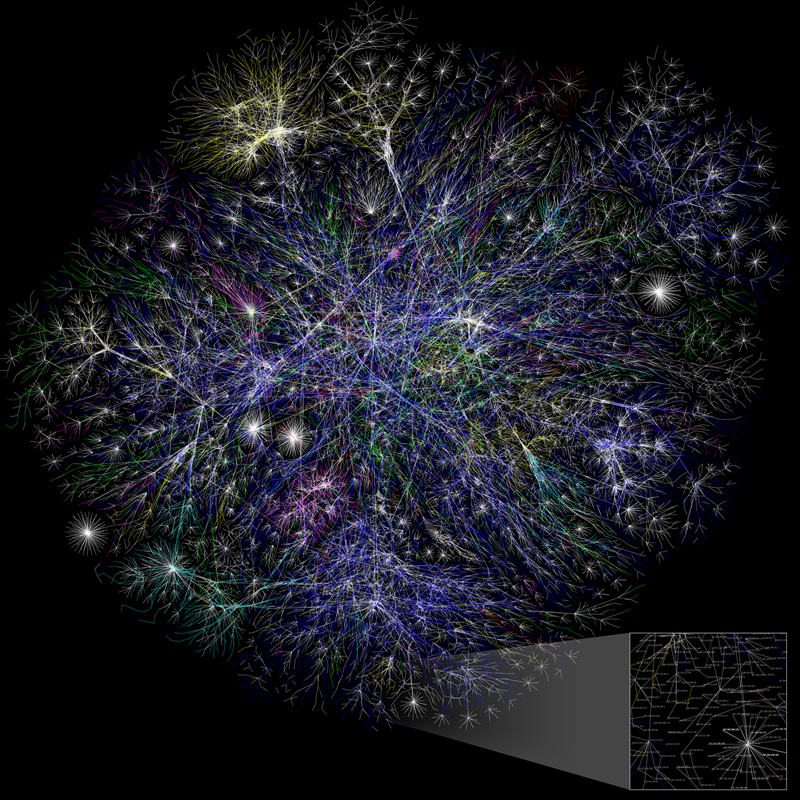Dr. Elizabeth Davis’s fourth and final Hack and Yack Series post. Enjoy!
In my previous post, I talked about how the process of accumulating, inventorying, and arranging work for portfolios helps students identify connections and themes among seemingly disparate projects and texts. In Darren Cambridge’s formulation, Web 2.0/3.0 tools and techniques like blogs, social media, and metadata foster a “networked” learning style that makes the learning process, in all its messiness, visible. The result is a more complex landscape of material that can be connected, analyzed, and made sense of. It also allows for the learning process to remain in process, as a network that can continue to accrue new data, new material, new links and ideas.

At the beginning of this series, I talked about my dissatisfaction with the digital research projects created by students in my course on writing for the Web and the source of that unhappiness being less the work itself than the sense that something was missing. That something is the network – the messy process of collecting, arranging, linking, and tagging that leaves a door (or several) open for others to step through and pick up a (or several) thread(s).
The problem, of course, is what such a research project might look like. A project oriented toward process, rather than product (i.e., the finished article or archive or exhibit) is something unusual in the humanities, where what we are generally expected to present at the end of a process of research is a text (defined variously) that subordinates the methodology to the final Word, the thesis that the text puts forward as authoritative, with the evidence and support marshalled at its back. The messiness of the learning process is polished away and, as a result, other potential directions or approaches or ideas may disappear.
At this year’s Computers and Writing conference, I explored the way a more focused attention to spatiality might help us develop an approach to research projects that are more about “enactment” and performance, a kind of performative art of research. As I noted there, Geoffrey Rockwell, writing in the 2011 Profession special section on “Evaluating Digital Scholarship,” argues that interaction is key to digital work and that we might do well to reconceive of humanities work as performative “works of art” onto which we bring our interpretive skills in analyzing their effects (162). Such a practice is post hoc, moving the text into the position of precursor or instigator of invention and interpretation.
The question then becomes how to create research “experiences” that, through interaction between text and reader/viewer/user provoke invention, inspire interpretation, and promote accretion. In thinking about how to compose in this way, I’m experimenting this semester with a new heuristic for my research assignment that I’m calling an Archeo-Geographic Curatorial Composition Assignment, in which the process looks like this (with “twenty-first century literacy skills” from Cathy Davidson’s list in the Appendix to Now You See It in parentheses, just to help me keep some clear learning goals in view):
- Collect (attention)
- Map > relations/spaces (network awareness, collaboration)
- Arrange > spatially: juxtapose/layer/align/collage (design)
- Select > categorize/collocate (assessment, narrative)
- [re]Arrange & [re]Map > navigate (network awareness, participation, collaboration)
- Reflect (attention)
- Propose/Persuade (attention, participation, collaboration, network awareness)
I have asked students in Writing for the Web to set up curatorial shop somehow (e.g., a tool that bookmarks, pins, captures) in which to collect digital items and objects that catch their attention and interest. Last week, we visited the Georgia Museum of Art here on UGA’s campus to wander and wonder at the way that exhibits are organized, arranged, and presented, and to think about how movement through physical spaces affects our perception and interpretation of what we see and the implications of that for digital composition.
Next week, we’ll try using mapping and visualization tools to make a first pass through those collections-in-progress in order to see where there may already be links, connections, gaps. In the coming weeks, we’ll use Susan Delagrange’s beautiful Kairos piece, “Wunderkammer, Cornell and the Visual Canon of Arrangement” (which we read prior to our museum visit), along with some visualization and mapping tools, to help us think about arrangement and visual analogy as an invention process. As they then move on to select and re-arrange and re-map, I want them to think of their work as the creation of an interactive exhibit or performance that will inspire their own interpretative analysis of what they have done and then, perhaps, to take a further step of making an argument for what their work “means.” And I want them to make something that will not simply be swallowed by the vastness of the Web, but that will draw others into its own textual web.
Clearly, I want a lot of things. I’m not sure how this approach will unfold nor what I will get – if it will be any different than the kinds of projects students have composed for me in the past. But I hope that by thinking of composing an experience rather than a text, I can help my students (and myself) think past a limited notion of what research is and does. I know that this spring’s Textual Machines symposium at UGA will provide great inspiration and ideas, and I have arranged to team teach Writing for the Web with a digital humanities colleague in the spring with an eye toward greater intermingling between the digital research tools and methods and the rhetorical and compositional concerns that affect the way we frame and present that research. And, of course, I will continue to be inspired in my pedagogy by eportfolio research and methods.
I hope that this blog series will serve as a node in a larger conversation, so please contribute your ideas, experiences, approaches, and insights. Let the process begin.
